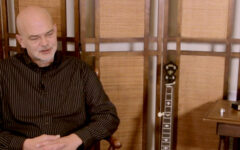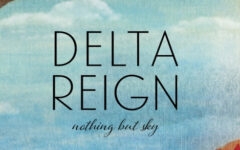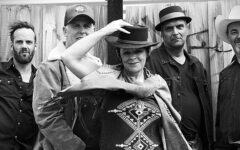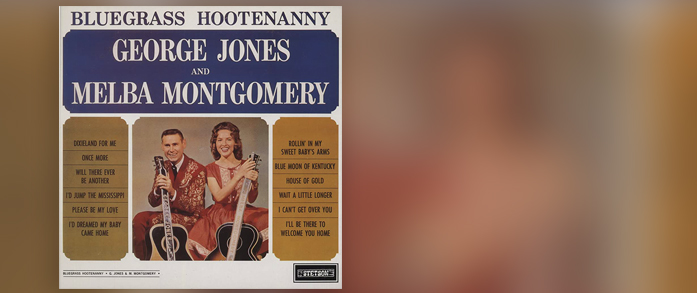
Much of Nashville, and all of country music, was absorbed yesterday with the memorial service for George Jones held at the Grand Ole Opry house. Friends and loyal fans turned out to remember this musical giant, who passed away on April 26.
Over the course of the many George Jones tributes that have come in from bluegrass artists, we were reminded of Bluegrass Hootenanny, the album he did in 1964 with his then duet partner, Melba Montgomery. It included 12 tracks of new and popular bluegrass and Gospel music, and was recorded with an A-list team of ’60s studio musicians.
Artists on the three sessions for Bluegrass Hootenanny were Curtis McPeake on banjo, Tommy Jackson on fiddle, Roy Husky on bass, Shot Jackson on dobro, Ray Eddington on guitar, and Pig Robbins on piano. The drummer’s name seems lost to history.
The track listing included:
- Dixieland for Me
- Once More
- Will There Ever Be Another
- I’d Jump the Mississippi
- Please Be My Love
- I Dreamed My Baby Came Home
- Rollin’ in My Sweet Baby’s Arms
- Blue Moon of Kentucky
- House of Gold
- Wait a Little Longer, Please Jesus
- I Can’t Get Over You
- I’ll Be There to Welcome You Home
It was released on United Artists, and has been out of print for some time, though it is still offered in digital format.
We reached out this week to Melba Montgomery and Curtis McPeake, who both have vivid memories of this album, and happily shared them for this overview of this historic recording.
Montgomery told us that she was a bluegrass fan from childhood.
“I always loved bluegrass. My dad played the old timey fiddle, and my mom played guitar and banjo. To me it was really close to the same music as we heard growing up.
The Osborne Bothers were great – and we played a lot of package shows with them, and Jim & Jesse and Flatt & Scruggs. We did a few shows with Bill Monroe, too. Of course he was the daddy of them all.”
We wondered if George was a fan as well.
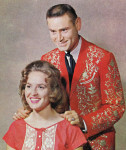 “Yes he was – he loved bluegrass. A lot of time we’d be traveling together, and sing Blue Moon of Kentucky in the car, and lots of other bluegrass songs. He loved Gospel, bluegrass and country, and he could sing ’em all.
“Yes he was – he loved bluegrass. A lot of time we’d be traveling together, and sing Blue Moon of Kentucky in the car, and lots of other bluegrass songs. He loved Gospel, bluegrass and country, and he could sing ’em all.
George was the all time greatest country music singer in the world. He had so much soul and so much feeling in his voice. And that tone he had.
It was such an honor to get to record and work shows with him. I’ve been very very blessed through my career.”
Bluegrass Hootenanny was released at the peak of the Jones/Montgomery collaboration. They had tremendous success together in 1962-’63, and Melba had a popular solo project in ’64 as well. When she and George dissolved their partnership in 1966, she continued to record and perform on her own, finding chart success in the 1970s. She retired from music about ten years ago.
Both Montgomery and McPeake recall the mid-’60s for the hootenanny craze, when that word had become a marketing touchstone. ABC had a very popular folk music program called Hootenanny on television, and producers and record labels were hot to capitalize on it.
Pappy Dailey, who had been producing Jones for some time, came up with the idea according to Montgomery.
“Pappy said why don’t we just do a hootenanny album and call it that. We had been planning to do a bluegrass album anyway, and we had a hoot of a time recording it!
Me and George picked the songs we wanted to sing. Pappy didn’t care what we did.
George did all our recording on one microphone – some duet singers used two mics, but we just used one – on stage and in the studio.”
McPeake, who was Nashville’s first call banjo picker in those days, said that he was initially surprised to get a call for banjo on a George Jones session.
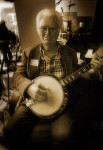 “George didn’t do that kind of stuff, but he wanted to do this one and so we did. I think we did it in three sessions. One afternoon and then the next morning and afternoon. These were three hour sessions, and you were allowed to cut four songs by union rules.
“George didn’t do that kind of stuff, but he wanted to do this one and so we did. I think we did it in three sessions. One afternoon and then the next morning and afternoon. These were three hour sessions, and you were allowed to cut four songs by union rules.
I clearly remember being there, and we did it all off the cuff. No big production.
As good a singer as George was, you could just give him a song and he would run with it.
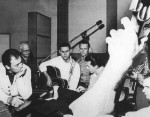 We got through the first session that afternoon, and I told George I had a song I wrote, and that he might like. He said, ‘Yeah… bring it in in the morning.’ So I brought it in and laid it out on the piano and started humming and singing my way through it.
We got through the first session that afternoon, and I told George I had a song I wrote, and that he might like. He said, ‘Yeah… bring it in in the morning.’ So I brought it in and laid it out on the piano and started humming and singing my way through it.
He picked that song up, walked over to the mic and sang the crap out of it.”
That song was Dixieland For Me, which ended up being the album’s first track, one that Curtis wrote with David Watkins.
McPeake is a true icon in the bluegrass banjo world. He went on to tour with Danny Davis and the Nashville Brass, and even had the honor to fill in for Earl Scruggs with Flatt & Scruggs when Earl was injured in an auto accident in 1955, and on a few subsequent occasions.
“I guess I was doing about 90% of the banjo work in Nashville back then, and that was really no big deal. You might get 3 sessions one week, and then nothing for another month.
I worked all over the country with Danny Davis, and a lot of other countries too. We worked a lot in Europe and even took that band to Saudi Arabia.”
Since retiring some time ago, Curtis has become a go-to-guy for serious collectors of prewar banjos.
While they were singing together, Montgomery remembers performing songs from Bluegrass Hootenanny on their stage show, especially Rollin’ In My Sweet Baby’s Arms.
Thanks to Curtis McPeake and Melba Montgomery for sharing their reminiscences of Bluegrass Hootenanny, and to Carl Jackson and Charlie Cushman for their help in putting things together.

